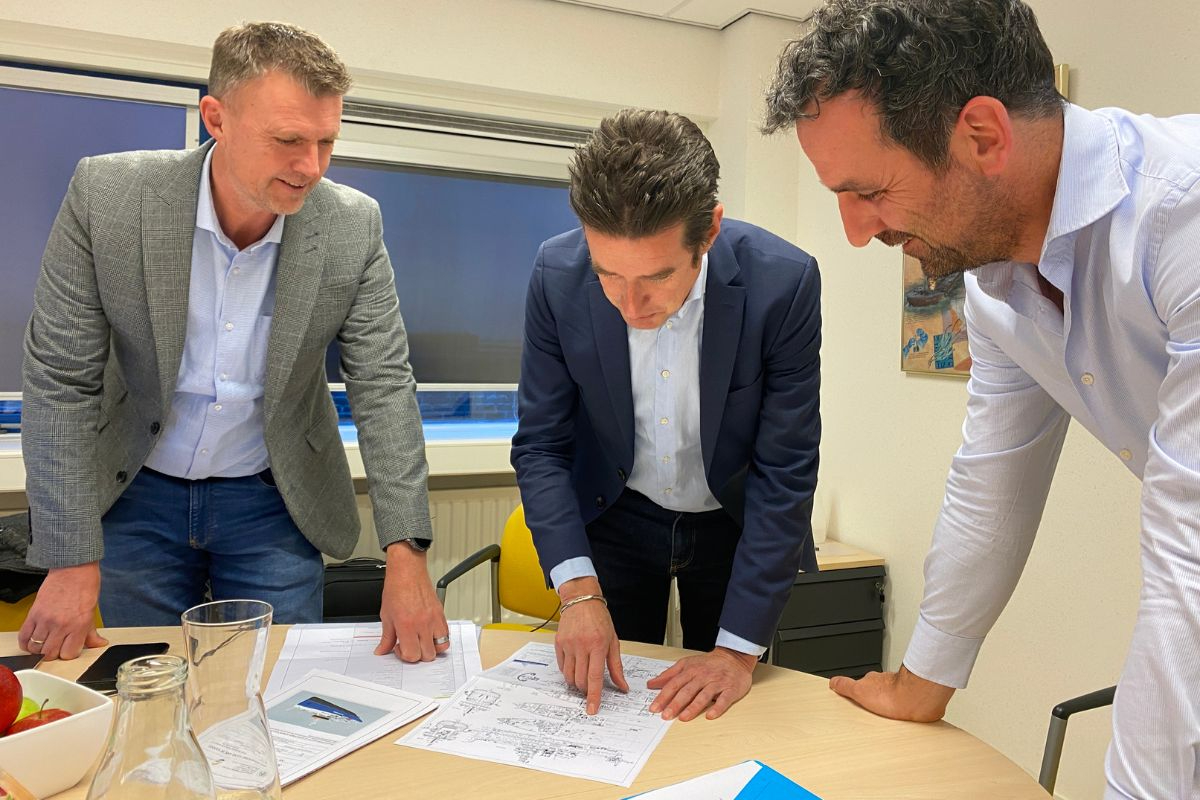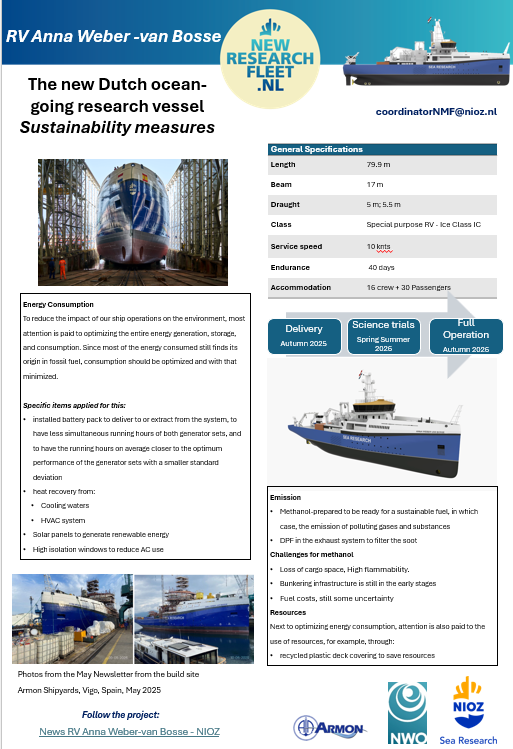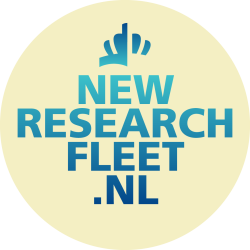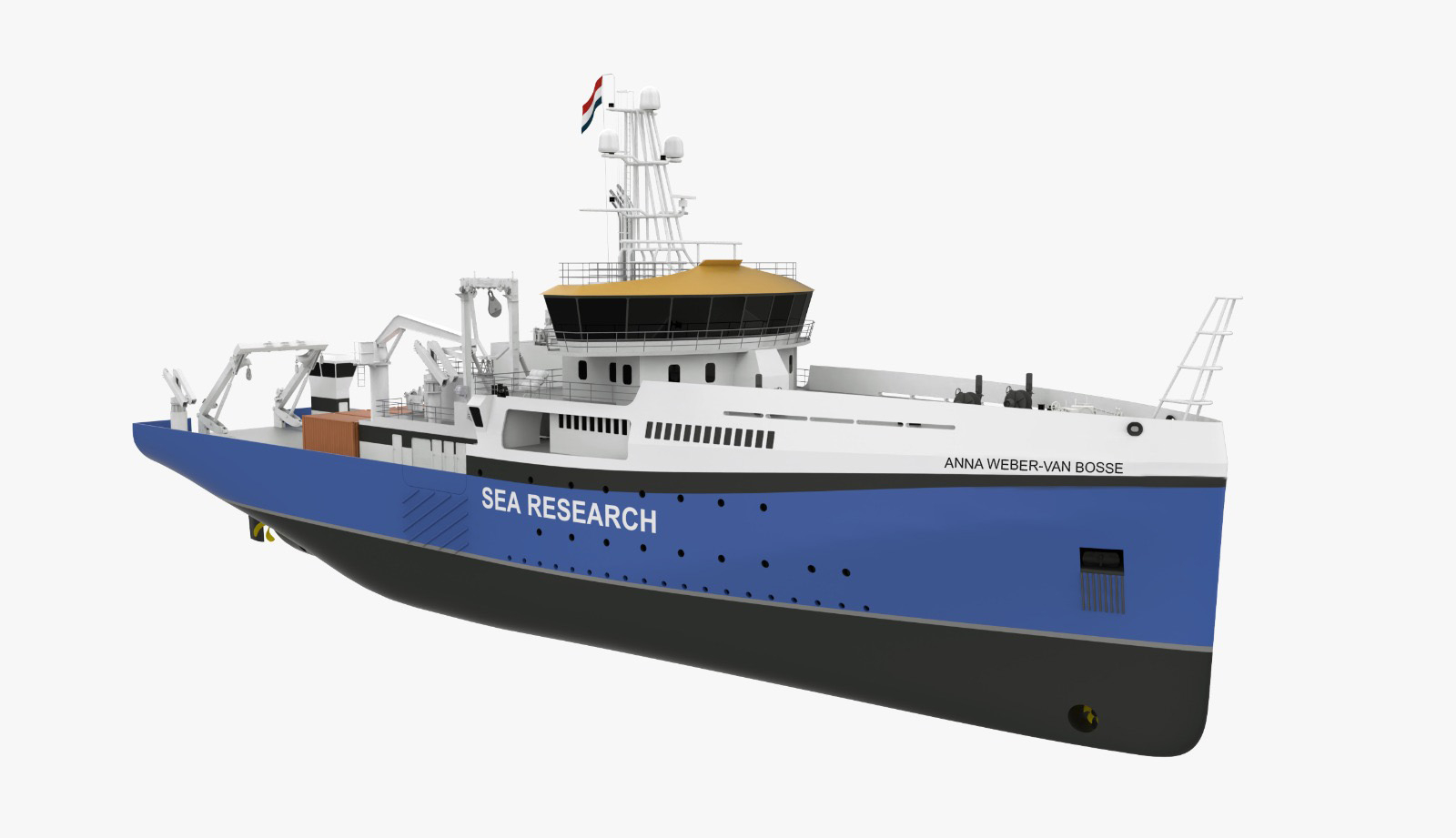An interview with Gert-Jan Reichart and Johan Hoogerhuis about the special characteristics of RV Anna Weber-van Bosse. Gert-Jan is head of the NIOZ Department for Ocean Research and a member of the Taskforce Fleet Replacement. He was involved - already from the start in 2015- in identifying the needs of the Dutch marine research community and also closely involved in drafting the Programme of requirements. Johan works at Navis and will take on the technical supervision on the shipyard.
~Dutch translation below English, please scroll down ~
1. Why does the RV Pelagia need to be replaced?
"The current Pelagia is more than 30 years old, and is approaching the end of its technical and economic service life. She therefore needs to be replaced based on technology, ergonomics, safety and sustainability considerations. Today’s technology presents opportunities to build a vessel that helps achieve the national research fleet’s green ambitions."
2. How were the technical specifications drawn up?
"The technical specifications were drawn up based on the scientific requirements for using the vessel as a research ship, and the technology that is currently available to facilitate that as effectively as possible. These considerations resulted in a state-of-the-art design that pays considerable attention to sustainability."
3. How can you predict the future 30 years in advance?
"Predicting the future is difficult, because there are different insights into how to make the platform sustainable and how quickly it can be rolled out. The RV Anna Weber-van Bosse was designed to be CO2-neutral within 10 years. The chosen design will be able to switch to using methanol as a fuel in the future, and the vessel is for the most part prepared for this transition. As part of the focus on sustainability, the vessel is also equipped with a battery pack. The Anna Weber-van Bosse has furthermore been conceived as a living lab, and future energy sources can be added to the onboard power grid to test them for the development of these future sources."
4. How much freedom did the shipyards have during the tender negotiation rounds?
"The NIOZ started the tender process with the design drawn up by C-Job. This design applied all of the requirements pertaining to science and the crew, using state-of-the-art technologies. The crew and the scientific community had considerable influence on the design process and the technical specifications. The participating shipbuilders received this information along with the call for tenders, and were asked to come up with a design that met the NIOZ’ requirements. The builders were given complete freedom to respond to this request. This resulted in the three participating shipyards presenting three different designs, each with their own specific advantages and disadvantages. "
5. To what extent are the design and specifications fixed at the moment the contract was signed?
"Approximately 80% of the design and specifications are definitive at the moment, which guarantees the desired input. The main requirements for issues such as sea handling, classification, etc., are 100% definitive. The remaining elements will be elaborated and refined over the course of the construction process."
6. What are the most innovative/unique/noteworthy aspects of this vessel?
"The most innovative aspect is that the vessel will be prepared to operate on methanol fuel. All fuel tanks, lines, layouts, etc., have been adapted for the future use of methanol. Plenty of space has been set aside for methanol storage on board, and the fuel tanks are not fixed to the hull. The vessel’s green characteristics have also been implemented in as many onboard systems as possible, and the design features options for the installation of a battery pack, solar panels and fixtures for wind foils."
7. Has a schedule been agreed upon with Armon?
"The project is scheduled to take 31 months from the moment the contract goes into effect. The first seven months will be devoted to the elaboration of the vessel’s design details. Model tests will also be conducted during this period. After this phase is complete, the shipyard will begin cutting the steel, building the sections and joining the sections to the hull. This period is expected to take approximately 16 months. During this phase, builders will begin installing the pipeline systems, pressurising the tanks, painting and other finishing work. The vessel will be launched once this phase is complete, sometime in mid-to-late summer 2024. The shipyard will then continue with the finishing work. The first HATs will commence in late 2024, and the shakedown cruises will begin in March 2025. Delivery is currently scheduled for mid-2025."

Een interview met Gert-Jan Reichart en Johan Hoogerhuis over de bijzondere eigenschappen van RV Anna Weber-van Bosse. Gert-Jan is hoofd van de afdeling Oceaanonderzoek van het NIOZ en lid van de Taskforce Vlootvervanging. Hij was -al vanaf de start in 2015- betrokken bij het inventariseren van de behoeften van de Nederlandse zeeonderzoeksgemeenschap en ook nauw betrokken bij het opstellen van het Programma van Eisen. Johan werkt bij Navis en zal het technisch toezicht op de werf op zich nemen.
Waarom moest de RV Pelagia worden vervangen?
De huidige Pelagia is inmiddels ruim 30 jaar oud en is aan het einde gekomen van de technische en economische levensduur. Ze dient daarom vanuit het oogpunt van techniek, ergonomie, veiligheid en duurzaamheid vervangen te worden. De huidige technieken bieden de mogelijkheid om een schip te bouwen wat past bij de vergroening
Hoe is het programma van eisen samengesteld?
Het programma van eisen is samengesteld op de eisen welke door de wetenschap zijn gesteld om het schip als onderzoeksschip te gebruiken, en de techniek die tegenwoordig beschikbaar is om dit zo effectief mogelijk uit te kunnen voeren. Dit heeft geresulteerd in een state of the art ontwerp waar veel aandacht is voor verduurzaming
Hoe kun je bij het ontwerpen 30 jaar in de toekomst kijken?
In de toekomst kijken is lastig omdat er nog verschillende inzichten zijn hoe te verduurzamen en hoe snel dit platform wordt uitgerold. De RV Anna Weber-van Bosse is ontworpen om binnen 10 jaar CO2 neutraal te zijn. Er is gekozen voor een ontwerp wat in de toekomst over kan worden gezet op Methanol. Het schip is hier voor een groot deel op voorbereid. Verder heeft het schip een battery pack zodat hier de focus op verduurzaming ligt. Verder is de RV Anna Weber-van Bosse ook uitgelegd als 'living lab' en kunnen er toekomstige energiebronnen worden toegevoegd aan het boordnet om deze te testen en zo toekomstige energiebronnen te ontwikkelen.
Hoeveel vrijheid hadden de werven nog tijdens de onderhandelingsrondes in de aanbesteding?
Het NIOZ is de aanbesteding begonnen met het ontwerp zoals gemaakt door C-Job. In dit ontwerp zijn alle eisen van de wetenschap en bemanning verwerkt met toepassing van de huidige stand van de techniek. De wetenschap en bemanning heeft veel invloed gehad op het tot standkomen van het ontwerp en het daarbij behorende bestek. De aanbiedende werven hebben deze informatie bij het verzoek tot inschrijven gekregen met het verzoek een ontwerp te maken wat past van de eisen van het NIOZ. De werven hadden hierin alle vrijheid. Dit heeft erin geresulteerd dat er van de 3 inschrijvende werven ook 3 verschillende ontwerpen zijn gepresenteerd met ieder hun eigen voor en nadelen.
In hoeverre ligt het ontwerp met alle specs vast bij ondertekening van het contract?
Het ontwerp en bestek ligt voor ongeveer een 80% vast waarmee de beoogde inzet geborgd is. De belangrijkste eisen met betrekking tot bv zeegangsgedrag, klasse eisen etc, liggen voor 100% vast. Het resterende deel zal gedurende de bouw steeds verder gedetailleerd en verfijnd worden.
Wat is het meest vernieuwende aan dit schip?
Het meest innovatieve is dat het schip wordt voorbereid op het varen op Methanol. Tanken, leidingsystemen, indelingen etc zijn afgestemd om tzt over te gaan naar Methanol. Er is veel ruimte voor Methanolopslag aan boord waarbij de brandstoftanken nog steeds vrij van de huid zijn. Verder is het groene karakter van het schip doorgevoerd in zoveel mogelijk systemen aan boord en zijn er zaken als een batterijpakket, zonnepanelen en mogelijkheden voor het plaatsen van windfoils doorgevoerd in het ontwerp.
Kun je de globale fases voor de bouw van het schip aangeven?
De doorlooptijd van het project is 31 maanden na het effectief worden van het contract. De eerste 7 maanden zullen in het teken staan van het verder ontwerpen en detailleren van het schip. In deze periode zullen ook de modeltesten worden uitgevoerd. Na deze 7 maanden zal de werf beginnen met het snijden van het staal, bouwen van secties en samenbouwen van het casco tot een geheel. Deze periode zal ongeveer een 16 maanden duren. Tijdens deze fase zal er worden begonnen met het inbouwen van leidingsystemen, persen van tanken, schilderwerk en verdere afbouwwerkzaamheden. Als het schip dan compleet is dan zal het tewater worden gelaten. Deze milestone is gepland in midden 2024. Na deze fase zal de werf verder gaan met afbouwen van het schip. De eerste HAT’s zullen eind 2024 beginnen en de proefvaarten rond maart 2025 gaan beginnen. De oplevering staat gepland op midden 2025.
-
Specifications
- Length overall 79,98m
- Breadth moulded 17.00m
- Depth to main deck 8,70m
- Summer draught 5.00m
- Scantling draught 5,50m
- Gross Tonnage approx. 3481GT
- Accommodation 46 (16 crew and 30 scientists)

Improvements RV Anna Weber - van Bosse compared to RV Pelagia
- A large aft deck offers space for more modular research containers to conduct experiments at sea.
- The ice class will facilitate research closer to the edge of the ice, which is extremely urgent to study melting ice caps.
- The vessel will be equipped with DP2 to facilitate dynamic positioning with a high degree of precision, which is a requirement for working in windmill parks to study the ecology there.
- The drop keel makes it possible to use equipment for observations deep in the water column, without obstruction from the boundary layer.
- The design specifically addresses the use of autonomous devices (drones, Autonomous Underwater Vehicles) or Remotely Operated Vehicles (ROV).
- The vessel will be able to accommodate double the number of researchers on board, which makes it possible for multiple teams to work simultaneously, 24 hours per day.
- The A-frame on the aft deck is taller and stronger, so the German autonomous drilling system MEBO can be operated from the AWvB to obtain long core samples from the deep seas.
- In addition to traditional multibeam sonar equipment, the new vessel will also be equipped with a higher resolution multibeam to make highly precise measurements, especially in shallower waters.
Voordelen tov RV Pelagia
- Groot achterdek waardoor er ruimte is voor meer en wisselende onderzoekscontainers, ook voor experimenten op zee
- Door een ijsklasse is het nu mogelijk dichter bij de ijsrand onderzoek te doen, wat zeer urgent is door de smeltende ijskappen
- Het schip wordt uitgerust met DP2 en kan daardoor automatisch zijn positie vast houden, met grote precisie, een voorwaarde om in windmolenparken te mogen werken, wat belangrijk is om de ecologie daar te onderzoeken.
- Door de dropkeel is het mogelijk met apparatuur omlaag in de waterkolom te kijken zonder dat je last hebt van de grenslaag
- Het schip is specifiek geschikt gemaakt voor inzet autonome apparatuur (drones, Autonomes Underwater Vehilcle) en ook inzet van een Remotely Operated Vehicle (ROV)
- Het aantal wetenschappers dat kan opstappen voor expedities is meer dan verdubbeld, wat het mogelijk maakt meerdere teams tegelijk te laten werken en ook 24 uurs inzet
- Het A-frame op het achterdek is hoger en sterker gemaakt zodat we ook vanaf de RV Anna Weber-van Bosse het Duitse autonome boorsysteem MEBO kunnen inzetten om lange boorkernen uit de diepzee te kunnen ophalen.
- Het nieuwe schip krijgt naast de traditionelere multibeam ook een hoger resolutie multibeam die met name in ondieper water zeer precieze opnames kan maken

